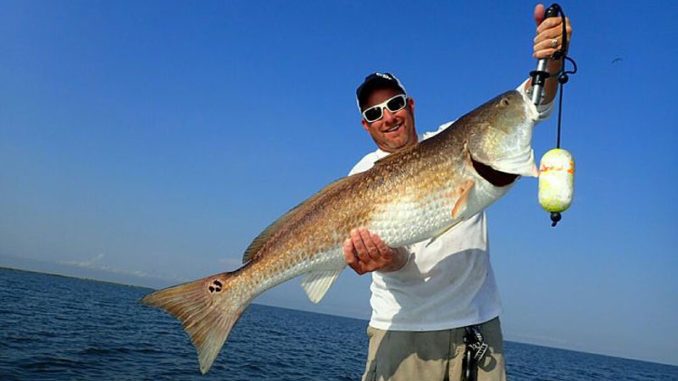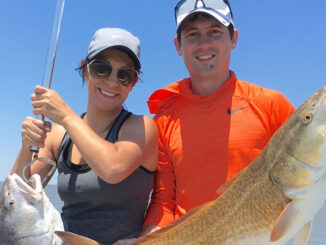
Sight-fishing for reds is fun and fruitful
Topwater frog fishing for bass is impossible not to love. Watch the blowup, set the hook and horse the fish out of acres of the thickest cover the area has to offer.
Delacroix-based fishing guide Capt. Casey Brunning certainly loves topwater fishing, so when conditions are right, he brings the frog-fishing game into sight-fishing redfish this time of year.
“When the grass gets really thick, the fish are in it, and it’s tough to get a lure to them, so the topwater frog is the most fun thing out there,” he said. “I’d love to be in 4 feet of clear water with grass that’s just below the surface, but usually we’re finding 2 1/2 feet of water with grass mats on top.”
Brunning chunks the frog as far as he can, and he makes some modifications that help him achieve that goal.
“The legs help it walk better, but when I’m fishing for redfish, I want to make as far of a cast as I can, and taking the legs off allows it to fly a lot further,” he said. “You don’t necessarily need that ‘walking’ style for a redfish to hit it. You just have to have something moving on top of the water.”
To achieve maximum distance, Brunnning adds a 1/16-ounce weight — which also gives a secondary benefit when fishing for reds.
“That weight makes it sit lower in the water, and I’ve found it actually gets a better hook-up ratio,” he said.
By cutting the legs off and adding weight inside the frog, Brunning is able to cast the frog a Cajun mile.
“On a full spool of line, I can almost throw the line down to the spool,” he said.
Important things to consider
In shallower conditions when there’s not a lot of water over the grass mat, the frog is a great presentation because it’s weedless. When water levels are up, Brunning switches to a more efficient method of sight-casting with a jighead.
Sight-fishing from a tall tower takes some getting used to. Brunning said the first thing anglers need to keep in mind is the trajectory of their cast.
“You’ll come up short a whole lot of times,” he said. “What is 10 feet in front of you on the deck of the boat, now you’re standing 8 feet high, and all of a sudden it becomes 15 feet, but it still looks 10 feet.”
As most anglers know, sunglasses are a critical part of sight-fishing. In fact, Brunning thinks they’re so important that he changes lenses to adjust with the conditions.
“If you don’t have polarized sunglasses, you’re defeating the purpose of sight-fishing,” he said. “You could have a school of eight redfish a foot under the water, 5 feet from the boat, and without glasses, you can’t see them.”


